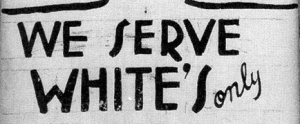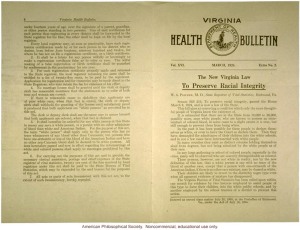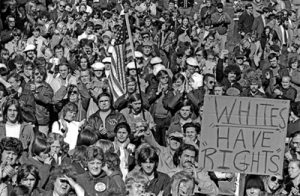By Ben Sichel. Ben is a teacher in Dartmouth and author of the P-12 education section for the Canadian Centre for Policy Alternatives’ Alternative Provincial Budget. Originally published at no need to raise your hand.
Many years ago, many people had no qualms about calling themselves “white.”


Today, more people seem to be squeamish about it. Students in class have occasionally asked me if we can use another word in place of “white” to describe people – “technically we’re pinkish”, one once said. In casual conversation people sometimes take pains to avoid the word, substituting terms like “Caucasian” or “of European descent.”
What is “Whiteness” anyway? Like race generally, it’s important to remember that Whiteness is a social construct, not something biological; and one that was deliberately created to categorize people into superior and inferior castes.
The history of racial classification is often quite absurd. In the United States, the infamous One-Drop rule categorized anyone with a trace of Sub-Saharan African ancestry as “black,” no matter their skin tone. Even today, the U.S. census lists five rather arbitrary racial categories: White, Black/African-American, American Indian/Alaska Native, Asian, and Native Hawaiian/Pacific Islander (with Hispanic/Latino falling under a separate “ethnicity” delineation). Considering how most people’s intuitive idea of “race” relates foremost to physical appearance, it’ll surprise some to learn that while two people with light skin and blue eyes could be categorized in different racial groups (say, White and American Indian), a person from Pakistan and a person from Korea could be lumped together under “Asian.” (Check out this on-line exercise to illustrate this absurdity.)
Race also changes over time and place. It’s safe to say that in the early 1900’s in North America, Jewish, Polish, Italian and Irish people among others were often not considered “white,” while for the most part they are today if they are light-skinned. In Brazil today, someone considered “white” might be considered “black” in Canada.
With such imprecise categories, why shouldn’t we avoid the term “white” (along with other racial denominations) completely? Simple: because whiteness has always denoted not a precise skin tone, but rather the location of power in a society.
The history of race is the history of racism itself, and racism necessarily involves one group of people holding power over another. In the early colonial United States, Howard Zinn writes that:
“in spite of special subordination of blacks in the Americas in the seventeenth century, there is evidence that where whites and blacks found themselves with common problems, common work, common enemy in their master, they behaved toward one another as equals.”
Laws forbidding white and black workers to fraternize and according special privileges to whites were put in place by landowning classes seeking to divide and conquer their workers.
These special privileges were enshrined in law and lasted from the days of chattel slavery all the way to the end of the Jim Crow era in the 1960’s. Once racism was no longer explicitly enshrined in law, it remained embedded in fact: some of the most egregious examples include redlining and the hyper-incarceration of African-Americans, in addition to daily microaggressions in everything from housing to employment to education.
(Canada has its own long, shameful history of racism, despite being the end of the Underground Railroad; my home province of Nova Scotia is nicknamed ‘The Mississippi of the North.’)
The flip side of racism is white privilege (as I’ve written before, and as many others have written much more capably and comprehensively than me). Systemic disadvantage for one group (or more) necessarily means systemic advantage for another.
Given the history of whiteness, it’s perhaps understandable that people would instinctively seek to avoid using the word “white” to describe themselves, even if they have trouble articulating why. But unfortunately, avoiding the term “white” means erasing the concepts of whiteness and white privilege. In other words, not saying “white” denies the fact that white privilege exists.
Is this denial deliberate? Maybe in some cases. But often I think it comes from a place many people feel is well-intentioned: the desire to be “ colour-blind (PDF).” Colour-blindness is a rather simple, we’re-all-the-same philosophy which many people espouse since it’s generally seen as an improvement over old-fashioned, overt racism. It’s the belief system under which people say things like “I don’t see race” or “I treat everyone the same.”
The problem with colour-blindness is that it makes it very difficult to talk about race and racism at all. It makes racism all about individual actions, and not at all about systems and institutions cemented over centuries that keep power concentrated in the hands of white people.
(The main reason power is concentrated is because it’s passed down from generation to generation – while theoretically anyone has the capacity to get rich and/or get a high-status position in society, it’s much easier if you start off with wealth and relative power already.)
According to the colour-blind ethos, mentioning race at all is impolite; hence, the avoidance of the word “white,” along with a hesitation to use racial or ethnic descriptors when talking about just about anyone.
The avoidance of “white” is a particular case, though. Too often, discussions on race and racism focus exclusively on disadvantages and injustices suffered by people of colour, without examining the corresponding unfair advantages held by whites. White people are socialized to see race as something external to ourselves; we see ourselves as raceless, neutral. To paraphrase what some students have said to me when asked to reflect upon their cultural and/or racial identity: “I don’t have one. I’m just normal.”
Not erasing the term “white” means accepting that whiteness exists – that although it is a social construct, it is a powerful one that bestows unearned privileges on its holders, whether they want them or not. This is not to take away from someone’s national or ethnic heritage: you can still be French, Irish, Scandinavian, etc. It’s simply to acknowledge that along with those things, whiteness has an effect on your life.
A caveat: I don’t presume to decide anyone else’s identity for them, and it’s important to remember that not everyone who “looks white” identifies that way. I know several people who to me appear European-descended but whose parents or grandparents are Black, Chinese or Indigenous American. Systems of racial oppression are complex and not based solely on physical appearance (although the related phenomenon of colourism is a reality in societies the world over).
Still, whiteness exists, and pretending otherwise by striking the word from our vocabulary does nothing to combat racism.
Note: Articles published by Solidarity Halifax members do not necessarily reflect positions held by the organization.
